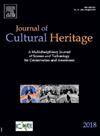米兰Sala delle Asse达芬奇壁画的多模式、多尺度非侵入性研究:一种支持清洁评估的工具
IF 3.3
2区 综合性期刊
0 ARCHAEOLOGY
引用次数: 0
摘要
米兰斯福尔扎城堡的Sala delle Asse在15世纪末由列奥纳多·达·芬奇和他的工作室装饰。由于涉及米兰公国的历史事件,房间的装饰在1499年中断,一些地区仍然没有彩色绘画。因此,粉刷过的表面被粉刷过,并被遗忘了很长一段时间,但在19世纪和20世纪,它们被重新发现并修复了两次,揭示了原始层的残余。近年来,该大厅一直是一个综合项目的重点,旨在彻底评估其墙壁的保护问题,并优化必要的干预方法。该项目的主要目标之一是恢复原始绘画残余的易读性。为此目的,用不同的方法对墙壁的特定部分进行了清洁试验。本研究采用多模式和多尺度的方法,对墙壁上清洁和未清洁的多色区域进行原位研究,以提供莱昂纳多·达·芬奇及其工作室使用的颜料的概述。此外,它还评估了清除19世纪和20世纪复涂漆的清洁程序的有效性,从而揭示了底层的涂漆层。非侵入性方法包括便携式微x射线荧光(基于点的测量和微测绘)、便携式拉曼光谱(点测量和微空间偏移拉曼光谱)和移动远程对峙光谱成像,在距离约10米的距离上进行。在远距离和近距离收集的成像和基于点的数据,具有厘米尺度的视野和亚毫米的空间分辨率(远程远距离成像),以及毫米和微米的斑点尺寸(点测量),为壁画未清洁和清洁区域中存在的材料的元素和分子组成提供了有价值的见解。允许部分重建地层,从而揭示15世纪的油漆残留;此外,该研究扩展了最新的非侵入性色素鉴定和清洁效果的综合评估协议。本文章由计算机程序翻译,如有差异,请以英文原文为准。
Multimodal and multiscale non-invasive study of Leonardo’s mural painting in Sala delle Asse (Milan): A tool supporting cleaning evaluation
Sala delle Asse in the Milan Sforza Castle was decorated by Leonardo da Vinci and his workshop at the end of the XV century. Due to historical events involving the Duchy of Milan, the decoration of the room was interrupted in 1499 and some areas remained devoid of polychrome paintings. For this reason, the painted surfaces were whitewashed and forgotten for a long-time, but during the 19th and 20th centuries, they were rediscovered and restored twice, uncovering the remnants of original layers.
In recent years, the hall has been the focus of a comprehensive project aimed at thoroughly assessing the conservation issues of its walls and optimizing the necessary intervention methods. One of the primary objectives of this project is to restore the legibility of the original painting remnants. For this purpose, cleaning tests have been conducted with different methodologies on specific sections of the walls.
This study employs a multimodal and multiscale approach conducted in situ on both cleaned and uncleaned polychrome areas of the walls to provide an overview of the pigments used by Leonardo da Vinci and his workshop. Additionally, it evaluates the effectiveness of cleaning procedures in removing 19th and 20th century overpainting, thereby revealing the underlying painted layers.
The non-invasive approach includes portable micro-X-Ray Fluorescence (point-based measurements and micro-mapping), portable Raman spectroscopy (point measurements and micro-spatially offset Raman spectroscopy), and mobile remote standoff spectral imaging, carried out at a stand-off distance of ∼ 10 m. The integration of imaging and point-based data collected at remote and close distance, with centimetre scale field of view and sub-millimetres spatial resolution (remote standoff imaging) and millimetres and micrometres spot size (point measurements), provided valuable insights on elemental and molecular composition of the materials present both in the uncleaned and cleaned areas of the mural painting, permitting a partial reconstruction of the stratigraphy and thus shedding light on the 15th century paint residues; moreover, the study expands the up-to-date protocols for the non-invasive identification of pigments and for an integrated evaluation of cleaning effectiveness.
求助全文
通过发布文献求助,成功后即可免费获取论文全文。
去求助
来源期刊

Journal of Cultural Heritage
综合性期刊-材料科学:综合
CiteScore
6.80
自引率
9.70%
发文量
166
审稿时长
52 days
期刊介绍:
The Journal of Cultural Heritage publishes original papers which comprise previously unpublished data and present innovative methods concerning all aspects of science and technology of cultural heritage as well as interpretation and theoretical issues related to preservation.
 求助内容:
求助内容: 应助结果提醒方式:
应助结果提醒方式:


